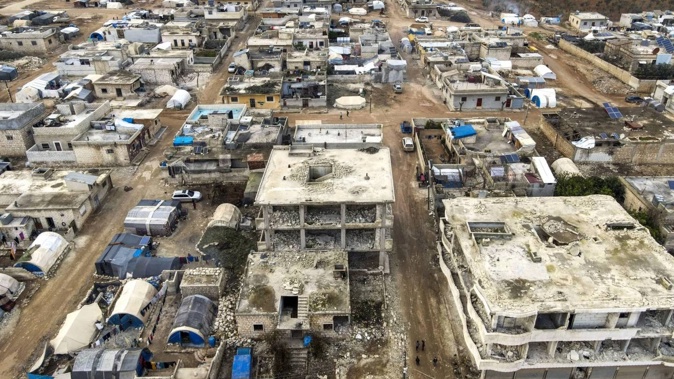
A year ago, a devastating 7.8 magnitude earthquake struck southern Turkey and northwestern Syria, causing widespread destruction and the loss of over 59,000 lives.
A massive rebuilding effort is still trudging along a year later but many questions remain about the future of the devastated areas.
What exactly happened?
The February 6, 2023 quake struck shortly after 4am and lasted for 85 seconds. It was followed by more than 570 aftershocks within 24 hours — including a magnitude 7.5 temblor to the north of the original epicentre in Turkey’s Kahramanmaras province.
According to the latest government figures released by Turkey’s Environment and Urbanisation Minister Mehmet Ozhaseki, some 680,000 homes either collapsed or were left too damaged to live in, leaving hundreds of thousands in desperate need of shelter.
The disaster led to a massive international rescue and aid operation involving dozens of countries and organisations. Early on, the hardest-hit areas were hard to get to, forcing residents to grab what tools they could to dig through the rubble. Rescue efforts in both countries were hampered by a lack of manpower and equipment. Damage to roads and airports, as well as bad weather, also obstructed the arrival of rescuers and aid.
/cloudfront-ap-southeast-2.images.arcpublishing.com/nzme/O4EVCYNGDVFLJJD7AQDQ7PP2MQ.jpg) People with their homes partially destroyed during the February 2023 earthquake live in tents in Antakya, southern Turkey. Photo / AP
People with their homes partially destroyed during the February 2023 earthquake live in tents in Antakya, southern Turkey. Photo / AP
In Syria’s northwestern Idlib province, the White Helmets rescue organisation blamed the international community for the delays while the Turkish Government faced criticism for its slow response, with many people waiting days for help.
Aid to Idlib, an opposition-held enclave, was initially restricted to one border crossing between Turkey and Syria, with the first aid shipment following the quake taking three days to reach survivors.
Mounting casualties and destruction
While TV images of survivors being pulled from the rubble raised hopes, the death toll climbed inexorably. The final count in Turkey reached 53,537 dead, the Interior Ministry said on Friday. The quake displaced some 3 million people and 11 provinces in Turkey were declared emergency zones.
In Syria, the United Nations said 6000 people lost their lives, the majority in Idlib. Other estimates put the number higher. The earthquake followed more than a decade of civil war that had severely damaged Syria’s infrastructure. Some of the worst quake-hit areas were also those most devastated by the conflict, including the city of Aleppo.
The World Bank estimated the damage caused at $34.2 billion in Turkey and $5.1b in Syria. However, the cost of rebuilding and the impact on the economy was much greater — at least $100b in Turkey’s case.
Constant seismic risks
Turkey is crisscrossed by fault lines, making it one of the world’s most earthquake-prone countries. The East Anatolian fault system, where the disaster occurred, is near where the Anatolian, Arabian and African tectonic plates come together.
The deadliest quake to hit Turkey in recent memory prior to last February’s was the 1999 magnitude 7.6 tremor that struck south of Istanbul, killing an estimated 18,000 people.
In 2020, the country suffered several major quakes, including the last serious one on the East Anatolian fault — a magnitude 6.7 quake in the city of Elazig that killed 41.
The East Anatolian fault had last seen a quake of magnitude 7 or greater in 1822, when at least 10,000 were killed in Syria’s Aleppo.
Why was the destruction so huge?
Turkey strengthened building codes after the 1999 Istanbul quake but experts say that lax enforcement, poor planning and alleged irregularities since then aggravated the 2023 disaster. Also, use of substandard material and lack of proper inspections during Turkey’s construction boom in the past years made matters worse, according to experts.
In Hatay, the worst-hit province, many settlements there were built on risky alluvial ground. Additionally, government amnesties for shoddy construction allowed transgressors to pay fines rather than tear down or fix dangerous buildings.
The delayed search and rescue operation also led to a greater loss of life, according to critics.
Months later, little aid trickled into Syria
In the weeks after the earthquake, humanitarian aid started flowing into Syria and a U.N. appeal raised nearly $387 million in pledges.
But months later, as other crises emerged, priorities for Syria appeared to fall by the wayside. To this day, humanitarian agencies are struggling to draw the world’s attention back to the war-ravaged country as they face donor fatigue and shrinking budgets.
Last June, an annual international donor conference held in Brussels for Syria saw lukewarm results and the following month, the World Food Programme announced it was slashing its aid in the war-wrecked country. In January, WFP ended its main food assistance scheme for Syria.
In many places, rubble remains where it fell as people struggle to survive in tents and prefabricated containers a year after the quake. Some 4 million people rely on humanitarian assistance amid a surge in violence in northern Syria.
- AP
Take your Radio, Podcasts and Music with you









